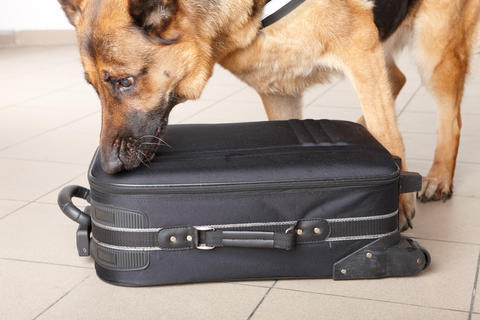Summary
As part of a multi-year interagency agreement between the Office of Standards of the Department of Homeland Security and NIST, NIST is developing measurement tools for and providing compositional data on explosives; investigating the mechanisms of canine olfaction; designing NIST Reference Materials (RMs); and promoting 'best practices' to evaluate the performance of dogs in the detection of trace explosives.
Description

Effective and accepted by the public, trained dogs are the most frequently deployed detection systems for identification of explosives threats in mobile applications. In addition to being highly sensitive, dogs can rapidly discriminate the unique profile of an explosive in a presence of a large excess of distracting odors, far exceeding the capabilities of current portable instrumentation. A key factor in effective deployment of canine detection is the use of appropriate training aids. Most commonly, real explosive materials are used for this purpose. However, this is a very expensive approach requiring appropriate storage bunkers, specialized explosives technicians, costly transport, and a well-documented chain of custody of these hazardous materials. Although there are a very limited number of vendors of non-explosive training aids, the ineffectiveness of these materials has been documented in the scientific literature and the materials have failed to gain widespread acceptance by the canine training community. The development of effective non-explosive reference materials for the training and performance evaluation of bomb dogs is a national priority.
Additional Technical Details
Canine olfaction of explosives is a complex problem that we believe consists of contributions from the 'head space' vaporous components as well as collected trace explosives particles. Our approach is to characterize the volatile, semi-volatile, and non-volatile composition of several common explosive formulations. A key element in establishing this metrological base for this study is to employ solid-phase microextraction (SPME) to determine the most volatile odorants, with an emphasis on quantitative measurements through the use of internal standards. Comprehensive solvent extraction will be used to determine the less volatile constituents. This information will be used to fabricate 'cocktail' mixtures of the odorants. Particulate materials containing these cocktail components, as well as dissolved 'real' explosives, will be prepared. An important facet of our investigation that differs from other research groups will be the emphasis on divining the role of explosives particles in canine detection, evaluating the effect of particle size on the efficacy of nasal collection. The evaluation of prototype particulate explosive materials will lead to the development of RMs for evaluating canine response. Packaging materials that are effective at releasing the RMs and are also suitable for training will also be an important part of our investigation. Finally, protocols for the use of the RMs will be promulgated through standards organizations such as SWGDOG and/or ASTM International.
Associated Publications
1. Verkouteren, R. M., Heckert, N. A., Leigh, S., Sisco, E., Norris, J. E., Lawrence, J., and Burns, A., "ASTM E2677: International Standard on Limit of Detection for Trace Detectors-Explosives, Opioids, and Ozone," Detection Limits in Air Quality and Environmental Measurements, 1618, 31-48 (2019).
2. Gillen, G., Najarro, M., Wight, S., Walker, M., Verkouteren, J., Windsor, E., Barr, T., Staymates, M., and Urbas, A., "Particle Fabrication Using Inkjet Printing onto Hydrophobic Surfaces for Optimization and Calibration of Trace Contraband Detection Sensors," Sensors, 15, 29618-29634 (2015).
3. Irikura, K. K. and Johnson, R. D., "Is NO3 formed during the decomposition of nitramine explosives?," Journal of Physical Chemistry A, 110, 13974-13978 (2006).
4. Maccrehan, W. A. and Bedner, M., "Development of a smokeless powder reference material for propellant and explosives analysis," Forensic Science International, 163, 119-124 (2006).
5. Maccrehan, W. A., Bedner, M., and Benner, B. A., "Development of NIST reference materials supporting explosives measurements," Abstracts of Papers of the American Chemical Society, 230, U342 (2005).
6. Maccrehan, W. A., Reardon, M. R., and Duewer, D. L., "A quantitative comparison of smokeless powder measurements," Journal of Forensic Sciences, 47, 1283-1287 (2002).
7. Munder, A., Christensen, R. G., and Wise, S. A., "Microanalysis of Explosives and Propellants by Online Supercritical Fluid Extraction Chromatography with Triple Detection," Journal of Microcolumn Separations, 3, 127-140 (1991).
8. Munder, A., Chesler, S. N., and Wise, S. A., "Capillary Supercritical Fluid Chromatography of Explosives - Investigations on the Interactions Between the Analytes, the Mobile Phase and the Stationary Phase," Journal of Chromatography, 521, 63-70 (1990).

